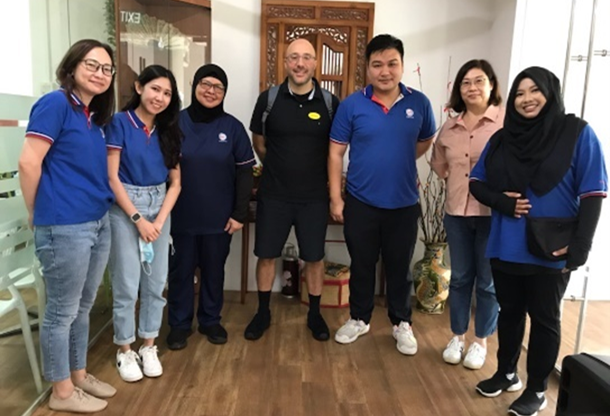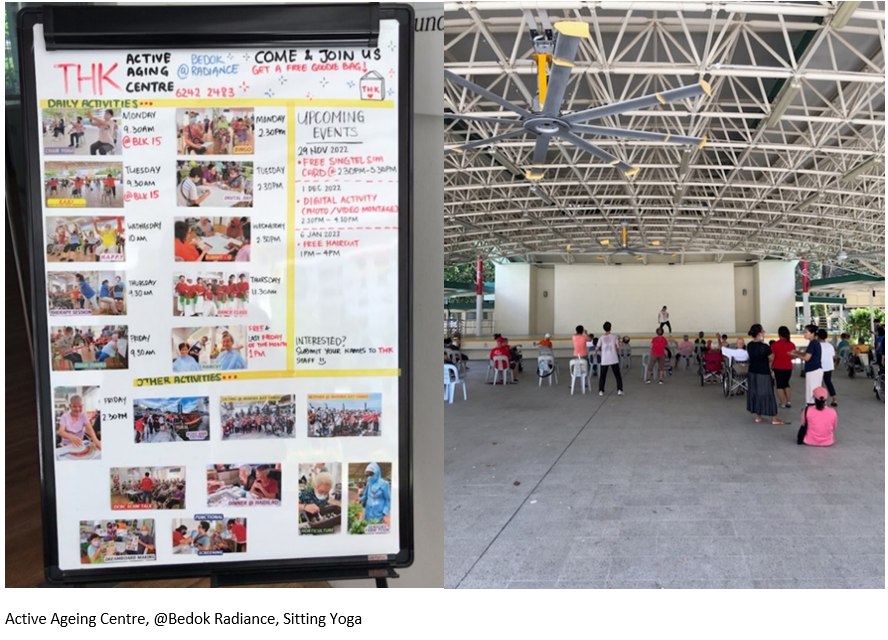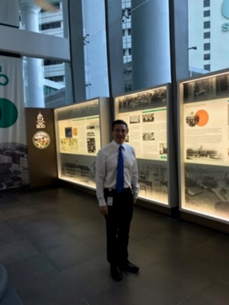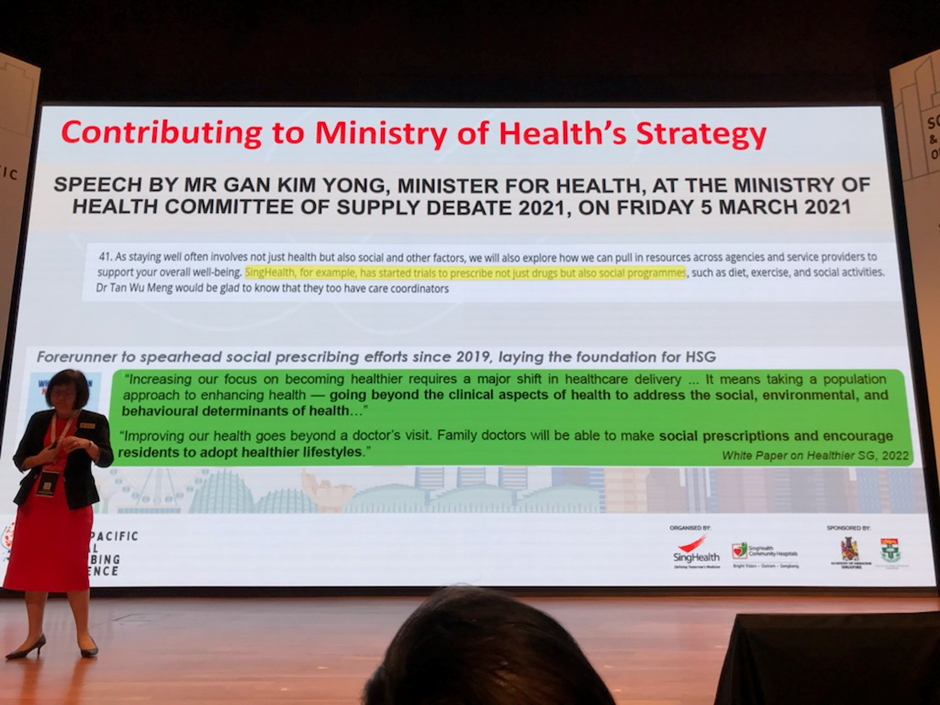Part 2 of this 3 part blog chronicles Felix’s time in Singapore and at the 1st Asia Pacific Social Prescribing Conference
Day 1
James Sanderson, one of the keynote speakers at the 1st Asia Pacific Social Prescribing Conference, Director of Personalised Care at NHS-England, and founder of the National Academy of Social Prescribing, tells me the Sing Health Social prescribing conference was long planned since Margaret Lee (CEO) and the SingHealth Community Hospitals team visited him in July 2019. The conference is happening at the same time as a UK Media backlash against social prescribing by The Times and Daily Mail and others deploring the lack of traditional evidence supporting NHS England’s “taking a £500m punt at the roll-out of social prescribing link workers in primary care, and chasing its tail with providing an evidence base ever since” with a carefully worded and interesting response by our team (Kerryn Husk) and UK academics.Feeling an impostor and under pressure to adequately represent the UK perspective at my 90 minutes post-conference workshop on ‘Social Prescribing Programme Evaluation’, I make sure to reach out to NASP, James Sanderson, the Social Prescribing Network, and academic colleagues like Debra Westlake to get it right – thank you everyone.
Having done my PhD on daytime functioning and sleep disorders, I pre-adjust my inner clock by spending the week before the trip getting up early, sitting in front of my SAD lamp, and dropping Melatonin (ordered from France) in the early evenings. I will have been glad to research the Singaporean health and care system which is very similar and very different to the UK – allowing me to target my messages to increase relevance. I also study business etiquette making sure to get the order of names right (second name comes first followed by two first names, always use the title and formal second name at first encounter), waiting for hands to be shook by more senior people, respectfully greeting by hand on heart for women – if in doubt. I also ditch my vaping device on the stopover at Doha airport (mostly civil and nicely diverse soccer fans on the impressive Airbus380 flying out of Terminal 5 Heathrow), with the prospect of imprisonment for bringing in nicotine products being a helpful public health deterrent to ditch that habit for the stay (a taxi driver assures me it is mainly a tax thing as I ask about Singapore introducing an even stricter smoking ban in July 2022).
I spend the first day, the Sunday, walking for over an hour (everything in Singapore is usually a 15mins Taxi ride away) in the balmy, humid average 28 degrees to the Botanic Gardens, where I am surprised by a raft of otters crossing my path – cute and scary (I later learned that many of the early conference attenders all made their way to the gardens for some green prescribing, shinrin-yoku or forest-bathing as the Japanese call it). A taxi driver tells me otters are a real pest, and rich folk don’t like them as they eat their expensive Koi Carps out of their ponds. I dare to visit the consumerist heaven of Orchard Road shopping malls and find Sanctuary Gaming tucked away on the fourth floor of one of the malls, observing around 60 grown-up children cramped into the shop in a qualifying tournament of Pokémon (getting those rare Japanese cards for my 5 and 7 year olds; tick). Safe back at the formerly Grand hotel (no complaints – great views and breakfast, it smells slightly musty, and grateful for the air-con), I check in with a call to my mate Roger Munns (an award-winning underwater cameraman, and fellow fan of blue prescribing) who lives across the South China Sea in Kota Kinabalu, Borneo. He says it is helpful to think of Singapore as one big corporation. He advises me, that if in doubt, to be sparing with the jokes in my post-conference engagement.
At the evening dinner invitation by the indelible Lee Kheng Hock I meet with those international guests arriving early, including the amazing Kate Mulligan from Toronto who is just in the process of setting up a Canadian Institute of Social Prescribing, the indefatigable Sian Slade from Melbourne, the quietly compelling Naoki Kondo from Tokyo, and the prolific Janet Bettger from Duke University which has a substantive partnership with SingHealth. We don’t really watch the footie in the background (Japan is winning) and develop a real camaraderie and excitement for the global social prescribing movement (see theirs and Kerryn’s recent paper, and the Global Social Prescribing Alliance).
Day 2 – A brief ethnography of active ageing
With my ethnographic hat on, considering everything as data, and wanting to understand how social prescribing works in Singapore before the conference – I had separately arranged to see community in action by reaching out to Andy Lee from Thye Hua Kwan Moral Charities (THKMC), who sat on the panel on the virtual conference the week prior to my trip. On the Monday before the conference, I kindly get chaperoned and collected from the Hotel by one of his long-serving social workers and ‘Active Ageing Centre’ (there are 23 across Singapore operated by this charity) managers in the early adopter site for integrated care, in Bedok District (within the SingHealth Eastern Cluster). On the drive, we experience the incredible public housing and large-scale resettlement scheme conducted by the Singaporean government, a mix of rental and owned housing blocks – with my chaperone explaining that the outwardly visible difference between them is that privately owned blocks have gates surrounding them. I do not get a chance to look at one of the rental flats, which can be between 27 and 35sqm – some of them crowded with up to two families living in them. I learn from a taxi driver (yes, they are the true ethnographers), about his own cramped living standards and that the most expensive penthouse in Singapore went through the hands of James Dyson (yes, he who relocated to Singapore then back again) at somewhere around $50m. I learn about the respect and special benefits bestowed on the pioneer or Merdeka generation (those aged 16 or above before independence in 1965) and join some of them for sitting yoga in the heat but thankfully under the canopy (see below). I am intrigued by the sense of community cohesion and the ease in which befriending/weekly calls can operate in such dense urban spaces, by digitally enabled and integrated care provision, emerging links with community health teams, and the idea of offering micro-jobs to the lovingly called ‘seniors’. I hold hands then dance with carefully selected, Rhosna, a 73 year old ‘auntie’ who tells me of the loss of the love of her life (“You only get one chance”) and how the Active Ageing Centre has become an anchor point for her and many elder residents in the tower block above our head.

Andy Lee, social workers, community nurses and volunteer coordinators from one of the biggest charitable providers of welfare/social care in Singapore.

Trying to save a penny, I get hopelessly lost in the afternoon on the brilliant, cheap, brand-new, and under-used Mass Rapid Transit (MRT) underground train system – ending up catching a taxi (they are also cheap, and it only takes 15mins) drenched in a tropical thunderstorm and half an hour late to the excellently planned and organised dry-run for the conference the next day (hopelessly embarrassed, with the Germans being famous for their punctuality).
Day 3 – The conference
It is a sign of the scale, ambition and commitment that the conference is opened by the guest of honour Minister Desmond Lee, responsible for National Development & Social Services Integration, i.e. not coming from health. He speaks very humbly and impressively, and I am struck by how possible it is due to the size and resources available to implement change at pace and scale across Singapore. It is also a sign of the seriousness and courage by organisers to have Sir Michael Marmot calling in his keynote from Cambodia, where he was busy being an activist at the most senior level. His talk is similarly powerful to the one we saw at the ICIC conference in Spain. The social gradient is everywhere and the wider social determinants of health so relevant (on the post-conference day which he attends in person, he jokes about Hong-Kong irritatingly bucking the trend with higher-than-expected life expectancy). He skilfully and diplomatically peppers his data with recent, relevant data from across the Asia-Pacific region (the man loves a graph). I get tapped on the shoulder by Dr Loke of the Ministry of Health who visited in September. He is delighted to see me and says that he helped nudge SingHealth to invite me (and he was very keen to get another copy of our slide set). I am slightly uncomfortable with the VIP treatment and ask one of the army of newly trained well-being coordinators allocated as my personal minder (yes it is the same label as the Torbay Wellbeing-Coordinators) whether I can go to the toilet by myself. I learn that SingHealth have a school or institute for pretty much everything and the minister stays just long enough to ceremoniously open the SingHealth Community Hospitals Office of Learning (SCHOOL), an instrument for industrial scale teaching and roll-out of trained up wellbeing coordinators (social prescribers).
Over lunch I get whisked away for an impromptu site visit of the General Hospital next door by Prof Kenneth Kwek CEO, an impressively humble and approachable character. The SingHealth Campus is massive and constantly rebuilt. He proudly takes me up to a ward and we check out the many Smart Hospital features on corridors and bed-sides. I am surprised to hear that the Hospital is running at near-full capacity, similar pressure to UK from an increasing and complex demographic despite a large provision of community hospital beds and transitional care models (where there is more capacity), and with a real need to bolster up-stream, social and primary care (which is largely privately funded). I mention Sheena Asthana’s and Joanne Watson’s (Deputy Medical Director Torbay) research project around the New Hospital Programme in Torbay, and I plant my cunning plan to apply for academic visiting fellowships. We have so much to learn from East meeting West, most of all more of the collective ‘us’ rather than ‘I’.

Prof Kenneth Kwek, CEO Singapore General Hospital, showing me their new memorial and time capsule on SingHealth Campus.
Kate Mulligan, who is prolifically tweeting throughout the conference (@KateMMulligan), gives a fantastic afternoon lecture, talking passionately about ‘belonging’, emphasising that social prescribing is not just a pathway (citing Kerryn’s work) but a systems intervention. I join my breakout sessions focused on workforce and am inspired by some of the local wellbeing coordinators. Similarly to our wellbeing coordinators in Torbay and South Devon, they are talking about the opportunity for having time to care and exploring what matters (rather than what is the matter) with clients. My ears prick up on slight paternalist undertones, as words like medication adherence and treatment compliance filter through. They are also engaging on an impressive, large scale community mapping exercise in the digital format of a ‘Living asset map’. My heart sinks slightly as a lot of this ‘mapping’, ‘Single point of access’, ‘directory of services’ work is going on in the UK, often prioritising products over people/relationships (i.e. commodifying belonging which should be a given in a fair and just society). I can’t help reminding people in the Q&A that signposting is not enough and of the risk of social prescribing at scale being just another ‘pass-the-parcel’ single point of failure for complex and unmet need (like for example, the well-spirited ‘Improving Access to Psychological Therapies’ programme in the UK). I emphasise that the conversation (listening not fixing) – and, as Debra Westlake put it, – that ‘holding people’ must be key ingredients of any client journey.
The conference is closed by the fabulous host Ms Margaret Lee, CEO of SingHealth Community Hospitals who is open about the implementation journey as ‘continuous improvement over delayed perfection’, embracing a version of our Researcher-in-Residence paper’s key message of Argyris&Shön’s framing of ‘double-loop learning’. She proudly presents the impact her work has had on shaping Singapore’s recent policy drive, as featured on a number of local news outlets: 8days, CNA, Straits Times, Zaobao. The conference is attended by some 300 people, with around 1,000 people attending via live feed.

Margaret Lee closing the conference day with the impact of her team’s work in shaping policy
Look out for the final part of this blog, when Felix relates his post-conference fire-side chat with Sir Michael Marmot, and his lasting impressions from his time in Singapore.
